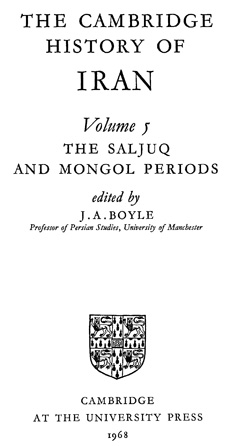|
ACKNOWLEDGMENTS
The editors and publishers are grateful to those who have given permission to reproduce plates in this volume.
Chapter I
The Political and Dynastic History of the Iranian World
(A. D. 1000-1217)
I. The Eastern Iranian World on the Eve of the Turkish Invasions
For nearly a thousand years—indeed, until our own century—Iran has generally been ruled by non-Persian dynasties, usually Turkish but sometimes Mongol or Kurdish. This domination at the highest level has had less effect on Iranian national psychology and literary consciousness than might be expected, for all of the alien ruling dynasties have come from races of low cultural development, and thus they have lacked the administrative expertise necessary for ruling a land of ancient settlement and civilization. Whether consciously or unconsciously, they have adopted Iranian culture at their courts, and they have been compelled to employ Iranian officials to administer the country and collect the taxes.
The first such alien rulers were the Saljuq Turks, who appeared in the Iranian world in the first half of the 5th/nth century. For them as well as for their successors, the process of assimilation to the indigenous culture and practices of Persia was not uncongenial, because they were able to draw on the country's ancient traditions of exalted monarchic power and submissiveness by the people. Moreover, in these traditions kingly authority was identified with divine authority, which helped the dynasties to rise above their tribal origins. The Saljuqs had originated as chieftains of nomadic bands in the Central Asian steppes. Their powers and ambitions often hedged about by a complex of traditional tribal rights and customs, the steppe leaders were little more than primi inter pares amongst the heads of all the prominent tribal families. With their entry into the Iranian world, the Saljuqs and their successors found the instruments at hand with which to make themselves, if they so desired, despots of the traditional Persian stamp: these instruments were a settled administration, a steady revenue from taxation, and usually a personal guard and standing army.
.....
| 